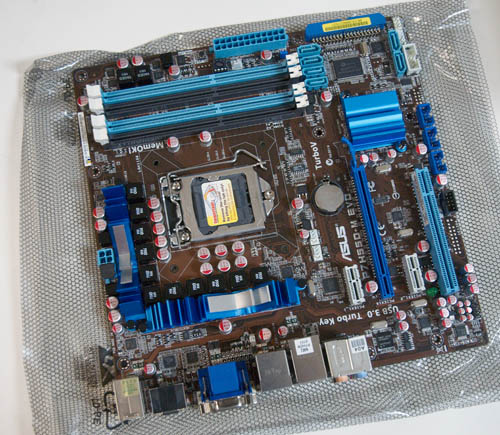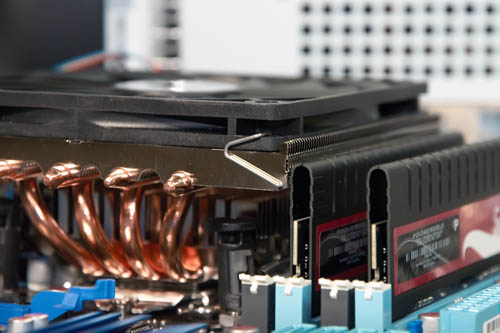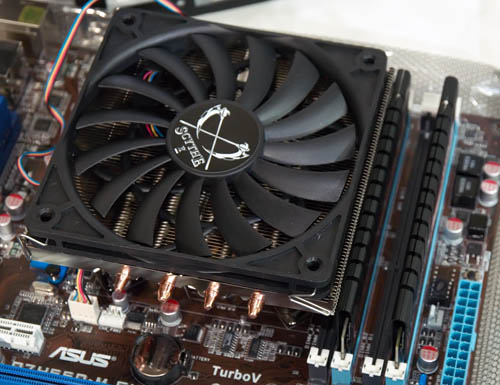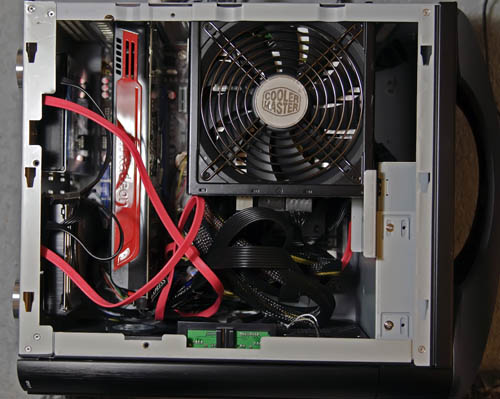The Pain of Assembly
Building a small form factor system is an exercise in flowcharts. If you’re using a highly compact case, like the Silverstone SG04B, the order of assembly is critical. The power supply, for example, goes in last.
The Asus motherboard offers a fairly clean layout, so there’s ample room for a large CPU cooler. However, I discovered late in the game that the SATA ports are poorly located, which means a long graphics card butts up to some of the SATA connectors. The board has plenty of ports, however, and does support USB 3.0, with an onboard NEC USB 3.0 controller.

Attaching the CPU cooler was challenging, too. I’ve generally liked Scythe coolers, but the designers often don’t think about how you actually mount the HSF. The Shiruken is a very low profile cooler, just 58mm high, including the skinny, 120mm fan. However, it’s fairly large, at 4.7 inches square. Plus, the Intel mounting tabs are under the radiator.
All this meant two things: I needed to install the HSF before installing the motherboard in the case.
Installing the cooler was an exercise in patience. I needed a large, flat bladed screwdriver, because there was no way I was going to get my fingers in between the HSF radiator and the top of the mounting pushpin, and still exert enough force to press the connector down until it snapped into place. Even then, I wasn’t 100% sure that all four pushpins had locked down.
And the Patriot memory modules, with their slightly taller silhouette, meant that two of the memory sockets weren’t usable. Lower profile memory modules would have allowed me to install four modules instead of two, if I wanted to go beyond 4GB.


Once the heat sink, CPU and memory were in place, the motherboard slid into the case nicely. It’s definitely a snug fit, since the case is just the right size for a micro ATX motherboard.
The biggest pain, though, was installing the Radeon HD 5850 graphics card. The XFX card is based on the reference design, and is 9.5 inches long. However, the power connectors are on the rear of the card. This had two consequences: you needed to attach the PCIe power plugs before installing the card in the case. Secondly, getting the card into the case meant slipping the card in at an angle, holding cables out of the way, and making sure you didn’t bump SATA or front panel connectors.
Due to the location of the SATA ports, I had to route the SATA cables over the top of the graphics card. Otherwise, I’d need to run them under the card, and that space is already pretty crowded.

The Silverstone case mounts hard drives in the base of the case, which is removable. However, as with the motherboard tray, space is tight, so you need to attach SATA and drive power after you close up the case bottom. I needed to be very careful, as the power adapter and SATA plug have barely enough room. It would be very easy to damage a SATA drive connector.
Once I figured out cable routing and got the graphics card running – which took several cycles of installing and removing the card, then re-routing cables – I booted the system. Everything was good. Installing Windows went smoothly.
The OCZ drive is fast, too. It’s in a 3.5-inch shell, rather than the more common 2.5 inch mechanism, and is really two 128GB modules pre-configured inside the shell for RAID 0. (Users never see the RAID configuration.)










81 Comments
View All Comments
pyrrhus819 - Wednesday, January 27, 2010 - link
I liked this article. I've been considering building a compact, and efficient but powerful system. This article gives me some good leads.One thing that concerns me, how can you determine if a particular component will fit, especially video cards? Do you just cross you fingers and hope for the best? I'm aware of the fact that many video cards are quite long. What is the "normal" length for a video card?
austin133788 - Thursday, January 28, 2010 - link
This is similar to I system I just recently built for myself at around the same price.-Shuttle SX58H7
-Core i7 920 C0 stepping overclocked to 3.2
-6 gigs 1600 Cas 6 memory
-2 Intel SSDs in RAID 0 (Boot Drive)
-WD Caviar Black 1TB (Storage)
-Samsung IDE DVD drive
-Radeon 5870 XXX Edition
This rig is screaming fast and came in right at $2000.00 from NewEgg.
I installed a 2 bay hot swap carriage for the SSDs to make it easier to upgrade in the future. Heck I love it so much I am contemplating building and selling these systems. I can even clock it at 3.4 and run the memory at 1700 CAS 7, but it's already plenty fast.
I chose the Shuttle because in an article I read it scored within a couple percentage points as the top of the line board at the time.
strikeback03 - Thursday, January 28, 2010 - link
Why the IDE drive?austin133788 - Thursday, January 28, 2010 - link
There are only 3 internal SATA connectors and 1 ESATA. I had already used the SATA connectors for the 2 SSDs and 1 HD.nubie - Wednesday, January 27, 2010 - link
Try a neater case for the same money, the GT3http://sportcompactpc.com/index.php?Itemid=17">http://sportcompactpc.com/index.php?Itemid=17
It comes with a power supply as well, although I think you have to use a laptop-style optical drive.
Bring on some more.
In fact, I thought this might be a mini-itx build, but I can keep hoping. I want to see a straight gaming cube as small as possible, with intelligent design.
You could cram a Core i5 and an ATI 5xxx in a Shuttle K45 (and yes there are power supplies that will power it safely, and the K45 comes with a place for a laptop optical drive) Just waiting on the motherboard I suppose, I hope they show up soon.
coachingjoy - Wednesday, January 27, 2010 - link
Have been using SFF boxes for awhile now, Shuttles mostly. Let us know how it turns out for OC'ing and everyday usage. SFF's are habit forming, be careful.LBID - Wednesday, January 27, 2010 - link
In my experience with video cards, "quiet" and "XFX" are not two words that belong on the same page, let alone the same sentence. I'd suggest looking at the Sapphire Vapor-X line if you want really quiet Radeon cards.fishbits - Wednesday, January 27, 2010 - link
This is honestly amazing. You spent $2100 on a PC with a 64-bit OS and only walked away with 4GB RAM? And only a dual-core processor?The real kick in the pants is its being billed as a "gaming rig." Why? Because this invalidates a lot of the assumptions going into the project. The tower is billed as small enough to take to a LAN party. I've owned some big towers, but not one too big to put in a car and carry, barring physical disability. It has low idle power--- for a gaming rig with a top-notch GPU. Like a Ferrari with a low-power glove compartment light. And whisper quiet--- for a gaming rig. If you're not allowed to operate a computer in your house that is louder than a whisper, buy headphones. Otherwise use speakers. In either case, a gaming rig is, by definition, going to make plenty of noise. From the games.
You could have gotten a better gaming rig for $1000 less, and hot-glued $100 bills to the case. You could have gotten better gaming rig AND a great laptop for the same price, if low sound levels and power consumption when not gaming were the priorities. It's almost as if the rationale was to bring a horribly bad build idea to life, or just to show that the builder can spend a lot of money. Heaven help Alienware for the thrashing they'd receive for offering up this level of performance at that price.
erple2 - Wednesday, January 27, 2010 - link
Wow. I'd say chill out, but ... wow.The choices made made perfect sense once you accepted the premise of the build:
1. Small and easily portable
2. Efficient at idle
3. Quiet
4. Gaming centric
None of your suggestions even qualify number 1, which was the most important qualification for this build. It's easily portable (not just "portable", as your suggestion is - though to be fair, even a Refrigerator is portable if you have a dolly). Your Ferrari analogy doesn't make any sense to me. This computer is supposed to be a small computer that is gaming focused. How does that compare to the efficiency of one minor component of that Ferrari?
Low Noise is a good thing in any build, with or without speakers. I appreciate a quiet case when I'm gaming, or just plain listening to music with that computer. And no, the rig itself is not supposed to make noise. That adds to background that I don't want to hear.
The choice of SSD was, as Loyd pointed out, a bit of an extravagance. In fact, he even suggested where you could reasonably trim down the cost a bit with some substitutions. However, each of those reduces the performance of the overall system, and sacrifices one of the key component of this build. I think Loyd made reasonable (other than the drive) choices for a very good gaming rig.
Finally - Wednesday, January 27, 2010 - link
AnandTech will rather spend $2100 on a ridiculous Intel machine than on an equal-performing AMD one, because this is what AnandTech does...